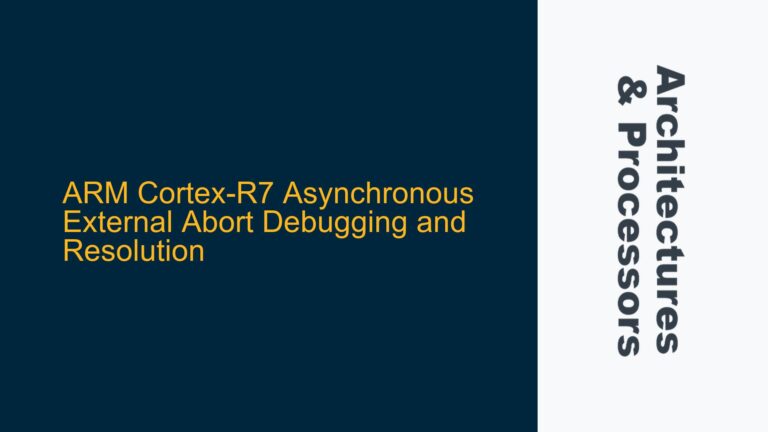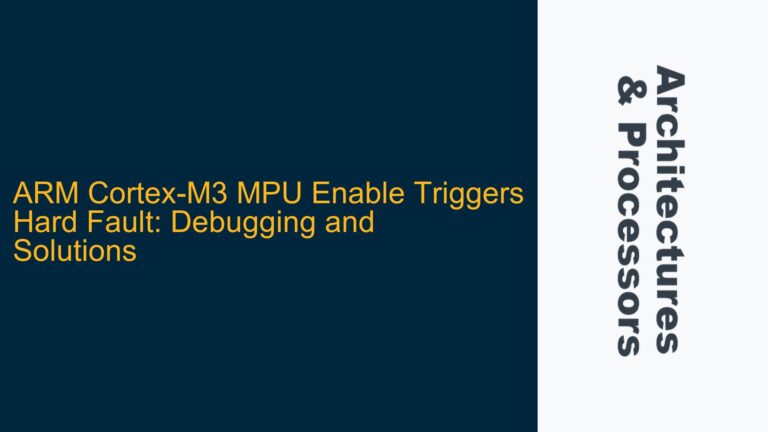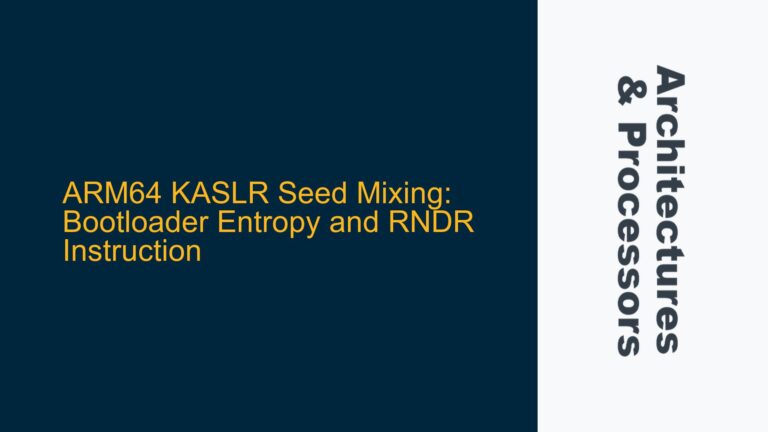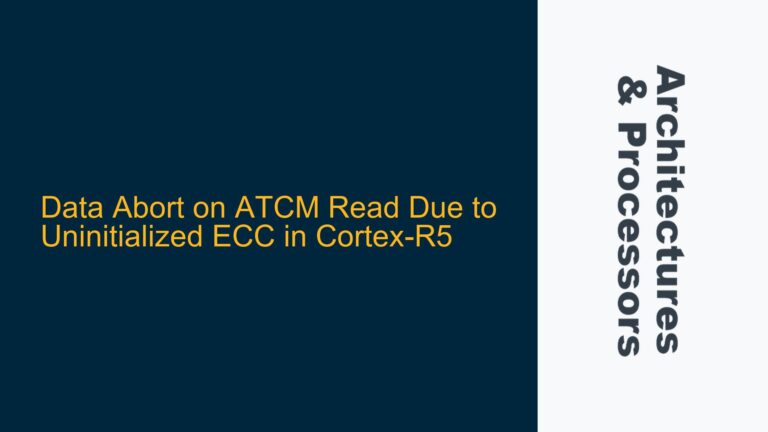ARM Cortex-A9 NEON Vectorization Failure in Nested Loops
The ARM Cortex-A9 processor, part of the ARMv7-A architecture, is widely used in embedded systems for its balance of performance and power efficiency. One of its key features is the NEON SIMD (Single Instruction, Multiple Data) engine, which accelerates data-parallel operations by processing multiple data elements in parallel. However, when implementing nested loops in code targeting the Cortex-A9, developers often encounter issues where the compiler fails to vectorize the loops using NEON instructions. This results in suboptimal performance, as the potential parallelism offered by the NEON engine remains untapped.
The failure to vectorize nested loops is a common issue, particularly when the loop structure is complex or when dependencies between loop iterations are not explicitly handled. The compiler’s ability to vectorize code depends on its ability to analyze the loop structure, identify parallelizable sections, and generate NEON instructions accordingly. When nested loops are involved, the compiler may struggle to determine whether vectorization is safe or beneficial, leading to the "not vectorized: multiple nested loops" warning.
Compiler Limitations and Loop Dependencies in Nested Structures
The primary reason for the failure to vectorize nested loops lies in the compiler’s limitations and the inherent complexity of loop dependencies. Compilers, including those for ARM architectures, rely on static analysis to determine whether a loop can be vectorized. This analysis involves checking for data dependencies, loop-carried dependencies, and memory access patterns. In nested loops, these factors become significantly more complex, making it difficult for the compiler to guarantee correct and efficient vectorization.
One common issue is the presence of loop-carried dependencies, where the result of one iteration of a loop depends on the result of a previous iteration. Such dependencies prevent the compiler from parallelizing the loop, as the order of execution must be preserved. In nested loops, these dependencies can span multiple levels of the loop hierarchy, further complicating the analysis.
Another factor is the memory access pattern. NEON vectorization works best when data is accessed in a contiguous and aligned manner. If the nested loops involve irregular or non-contiguous memory access, the compiler may determine that vectorization is not feasible. Additionally, the use of pointers or indirect addressing in nested loops can obscure the memory access pattern, making it difficult for the compiler to generate efficient NEON code.
The choice of compiler and its optimization settings also play a significant role. Different compilers have varying capabilities and heuristics for vectorization. For example, GCC, ARM Compiler (armclang), and LLVM may produce different results for the same code. The optimization level (e.g., -O2, -O3) and specific flags (e.g., -fvectorize, -ftree-vectorize) can influence the compiler’s ability to vectorize nested loops.
Loop Unrolling, Restructuring, and Compiler-Specific Optimizations
To address the issue of nested loop vectorization on the ARM Cortex-A9, developers can employ several techniques, including loop unrolling, loop restructuring, and compiler-specific optimizations. These approaches aim to simplify the loop structure, eliminate dependencies, and provide the compiler with sufficient information to generate efficient NEON code.
Loop Unrolling
Loop unrolling is a technique where the body of a loop is replicated multiple times, reducing the number of iterations and potentially exposing parallelism. For nested loops, unrolling the outer loop can simplify the structure and make it easier for the compiler to vectorize the inner loop. For example, consider the following nested loop:
for (int i = 0; i < N; i++) {
for (int j = 0; j < M; j++) {
A[i][j] = B[i][j] + C[i][j];
}
}
Unrolling the outer loop by a factor of 4 would transform the code into:
for (int i = 0; i < N; i += 4) {
for (int j = 0; j < M; j++) {
A[i][j] = B[i][j] + C[i][j];
A[i+1][j] = B[i+1][j] + C[i+1][j];
A[i+2][j] = B[i+2][j] + C[i+2][j];
A[i+3][j] = B[i+3][j] + C[i+3][j];
}
}
This transformation reduces the number of outer loop iterations and may allow the compiler to vectorize the inner loop more effectively. However, unrolling must be done carefully, as excessive unrolling can increase code size and potentially degrade performance due to instruction cache pressure.
Loop Restructuring
Loop restructuring involves reordering or combining loops to improve vectorization opportunities. One common technique is loop interchange, where the order of nested loops is swapped to optimize memory access patterns. For example, consider the following loop:
for (int i = 0; i < N; i++) {
for (int j = 0; j < M; j++) {
A[i][j] = B[j][i] + C[j][i];
}
}
In this case, the memory access pattern for arrays B and C is non-contiguous, which may prevent vectorization. By interchanging the loops, the access pattern can be improved:
for (int j = 0; j < M; j++) {
for (int i = 0; i < N; i++) {
A[i][j] = B[j][i] + C[j][i];
}
}
This restructuring ensures that B and C are accessed in a contiguous manner, potentially enabling vectorization. However, loop interchange is not always possible, particularly when there are dependencies between iterations.
Another restructuring technique is loop fusion, where multiple loops are combined into a single loop to reduce overhead and improve cache locality. For example, consider the following code:
for (int i = 0; i < N; i++) {
A[i] = B[i] + C[i];
}
for (int i = 0; i < N; i++) {
D[i] = A[i] * E[i];
}
Loop fusion would combine these loops into a single loop:
for (int i = 0; i < N; i++) {
A[i] = B[i] + C[i];
D[i] = A[i] * E[i];
}
This reduces the number of loop iterations and may improve cache performance, but it must be done carefully to avoid introducing dependencies that prevent vectorization.
Compiler-Specific Optimizations
Different compilers offer various flags and pragmas to guide vectorization. For example, GCC provides the -ftree-vectorize flag to enable automatic vectorization, while ARM Compiler offers the --vectorize option. Additionally, pragmas such as #pragma omp simd (for OpenMP) or #pragma clang loop vectorize(enable) (for LLVM) can be used to explicitly instruct the compiler to vectorize specific loops.
For example, using GCC, the following code can be compiled with the -O3 and -ftree-vectorize flags to enable vectorization:
gcc -O3 -ftree-vectorize -mcpu=cortex-a9 -mfpu=neon -o program program.c
In ARM Compiler, the following command can be used:
armclang --vectorize -O3 -mcpu=cortex-a9 -mfpu=neon -o program program.c
Additionally, developers can use compiler-specific pragmas to guide vectorization. For example, in LLVM, the following pragma can be used to enable vectorization for a specific loop:
#pragma clang loop vectorize(enable)
for (int i = 0; i < N; i++) {
A[i] = B[i] + C[i];
}
These compiler-specific optimizations can help overcome the limitations of automatic vectorization, particularly in complex nested loops.
Manual NEON Intrinsics
In cases where the compiler fails to vectorize nested loops, developers can resort to manual NEON intrinsics to explicitly write vectorized code. NEON intrinsics are functions that map directly to NEON instructions, providing a higher-level abstraction than assembly language while still offering fine-grained control over vectorization.
For example, consider the following nested loop:
for (int i = 0; i < N; i++) {
for (int j = 0; j < M; j++) {
A[i][j] = B[i][j] + C[i][j];
}
}
Using NEON intrinsics, this loop can be vectorized as follows:
#include <arm_neon.h>
for (int i = 0; i < N; i++) {
for (int j = 0; j < M; j += 4) {
float32x4_t b_vec = vld1q_f32(&B[i][j]);
float32x4_t c_vec = vld1q_f32(&C[i][j]);
float32x4_t a_vec = vaddq_f32(b_vec, c_vec);
vst1q_f32(&A[i][j], a_vec);
}
}
In this example, the vld1q_f32 intrinsic loads four single-precision floating-point values from memory into a NEON register, the vaddq_f32 intrinsic performs vector addition, and the vst1q_f32 intrinsic stores the result back to memory. This approach ensures that the loop is vectorized, but it requires a deep understanding of NEON intrinsics and careful handling of memory alignment and boundaries.
Performance Analysis and Profiling
After applying the above techniques, it is essential to analyze the performance of the vectorized code to ensure that the optimizations have the desired effect. Tools such as ARM DS-5 Development Studio, GCC’s -fopt-info-vec flag, and LLVM’s -Rpass=vectorize option can provide detailed feedback on vectorization success and performance.
For example, using GCC, the following command can be used to generate a report on vectorization:
gcc -O3 -ftree-vectorize -fopt-info-vec -mcpu=cortex-a9 -mfpu=neon -o program program.c
This will output information about which loops were vectorized and any issues encountered during the process. Similarly, ARM DS-5 provides a performance analyzer that can profile the application and identify bottlenecks, helping developers fine-tune their vectorization strategies.
Conclusion
Vectorizing nested loops on the ARM Cortex-A9 using NEON can be challenging due to compiler limitations, loop dependencies, and complex memory access patterns. However, by employing techniques such as loop unrolling, loop restructuring, compiler-specific optimizations, and manual NEON intrinsics, developers can overcome these challenges and unlock the full potential of the NEON SIMD engine. Performance analysis and profiling are essential to validate the effectiveness of these optimizations and ensure that the vectorized code delivers the expected performance improvements. With careful attention to detail and a thorough understanding of the ARM Cortex-A9 architecture, developers can achieve significant performance gains in their embedded applications.






